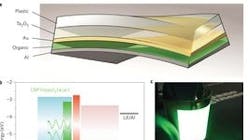Plastic OLEDs hit glass OLED efficiencies
Heavily doped glass substrates have been the key to getting high output efficiency out of organic light-emitting diodes (OLEDs). But a group of researchers at the University of Toronto think they have figured out how to get OLEDs fabricated on plastic to yield efficiencies equivalent to those of their glass-based counterparts.
Typical high-efficiency OLEDs require exotic high-refractive-index (n ≥ 1.8) substrates to get light out of the OLED. The problem with flexible plastic substrates that they have a low refractive index (n ≤ 1.6). So University of Toronto researchers led by PhD Candidates Zhibin Wang and Michael G. Helander set out to fix the problem. They report making high-efficiency phosphorescent OLEDs using a thin-film out-coupling enhancement method that does not depend on high-index substrates.
These devices contain multifunctional anode stacks consisting of a high-index Ta2O5 (tantalum(V) oxide) optical coupling layer, an electrically conductive gold layer, and a hole-injection MoO3 layer that is between 50 and 100 nanometers thick. Researchers collectively optimize the layer qualities to get high efficiency. They say the maximum external quantum efficiency reaches 63% for green, which remains as high as 60% at >10,000 cd m–2.
The researchers published their results in a paper titled "Unlocking the Full Potential of Organic Light-Emitting Diodes on Flexible Plastic," published online in the journal Nature Photonics.
The researchers also think their laboratory results could be scaled up into a commercial process that could produce working plastic OLEDs within the next five years.
The Nature Photonics article can be found here: http://www.nature.com/nphoton/journal/vaop/ncurrent/full/nphoton.2011.259.html
